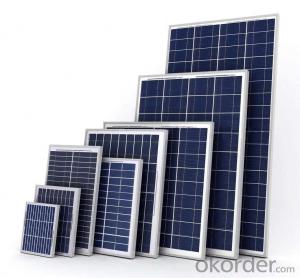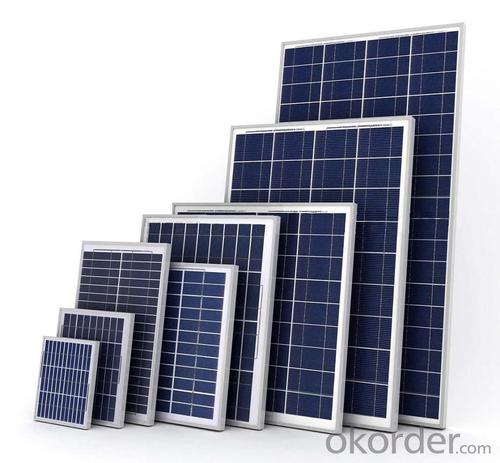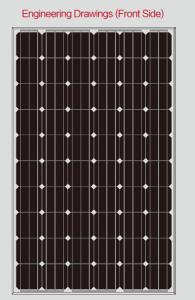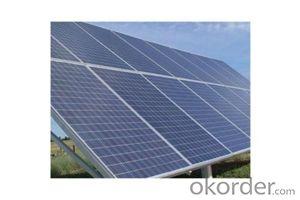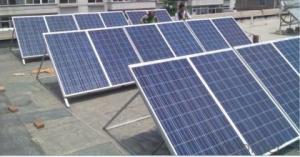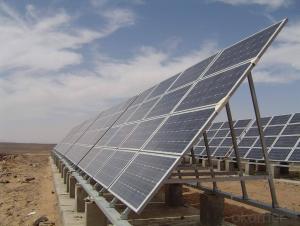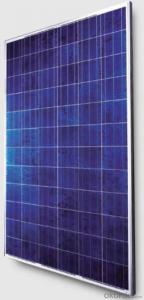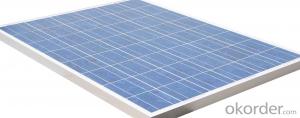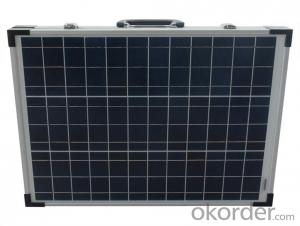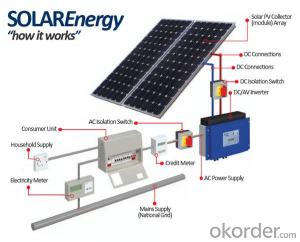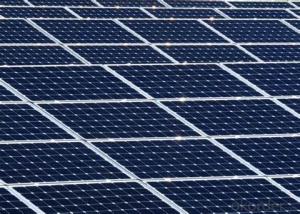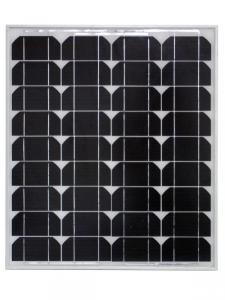High Efficiency Polycrystalline Solar Panels Illinois
- Loading Port:
- Shanghai
- Payment Terms:
- TT OR LC
- Min Order Qty:
- 1000 pc
- Supply Capability:
- 500000 pc/month
OKorder Service Pledge
OKorder Financial Service
You Might Also Like
Product Description:
PERFORMANCE
- High effi ciency, multicrystalline silicon solar cells with high transmission
and textured glass deliver a module effi ciency of up to 16.0%,
minimizing installation costs and maximizing the kWh output of your
system per unit area.
- Tight positive power tolerance of 0W to +5W ensures you receive
modules at or above nameplate power and contributes to minimizing
module mismatch losses leading to improved system yield.
- Top ranking in the “TÜV Rheinland Energy Yield Test” and the
“PHOTON Test” demonstrates high performance and annual energy
production.
RELIABILITY
- Tests by independent laboratories prove that modules:
Fully conform to certifi cation and regulatory standards.
Withstand wind loads of up to 2.4kPa and snow loads of up to
5.4kPa, confi rming mechanical stability.
Successfully endure ammonia and salt-mist exposure at the highest
severity level, ensuring their performance in adverse conditions.
- Manufacturing facility certifi ed by TÜV Rheinland to ISO 9001:2008,
ISO 14001:2004 and BS OHSAS 18001:2007.
WARRANTIES
- 10-year limited product warranty1.
- Limited power warranty1: 10 years at 91.2% of the minimal rated power
output, 25 years at 80.7% of the minimal rated power output.
1In compliance with our Warranty Terms and Conditions.
QUALIFICATIONS & CERTIFICATES
IEC 61215, IEC 61730, MCS, CE, ISO 9001:2008, ISO 14001:2004, BS OHSAS
18001:2007, PV Cycle, SA 8000
ELECTRICAL PERFORMANCE
Electrical parameters at Standard Test Conditions (STC)
| ELECTRICAL PERFORMANCE | |||
| Power output | P max | W | 190 |
| Power output tolerances | ΔP max | W | 0/+5 |
| Module effi ciency | η m | % | 14.7 |
| Voltage at Pmax | V mpp | V | 23.7 |
| Current at Pmax | I mpp | A | 8.03 |
| Open-circuit voltage | V oc | V | 30.1 |
| Short-circuit current | I sc | A | 8.65 |
- Q: For my Product Design Coursework I am designing an environment friendly building according to a clients' specifications. I need to find out the dimensions of 0000 watt solar panels. any help would be much appreciated!
- do those even exst that sounds prertty intesnse andn i see amny things that wou;ld go wrong with that i think you should like tone it done a bit that sounds pretty intense tho
- Q: I have tried researching on the internet and just cant find any real answer. I know that the amount of electricity produced when taking in the suns rays depends on the placement of the solar panels but I am just looking for ball park figures. Thanks
- Guide okorder /
- Q: Can solar panels be used in areas with high levels of snow or ice?
- Yes, solar panels can be used in areas with high levels of snow or ice. However, the efficiency of solar panels may be reduced during these conditions. Regular maintenance and snow removal are necessary to ensure optimal performance. Additionally, tilted solar panel installation and using anti-reflective coatings can help minimize snow accumulation.
- Q: Photo-Voltaic solar panels are very expensive. Most of a home's energy needs are for heating water, heating and air-conditioning. All of these can be met with thermal solar collectors which are much less expensive. The thermal solar panels would heat water stored in a hot water tank which then can be used as hot water, to heat the home, or as the heat source to a Lithium Bromide Absorption chiller to air-condition a home. With the base line needs met without expensive panels and without inefficient energy conversions, only a small Photo-Voltaic array would be needed for the remaining power needs and since those needs are variable, there would still be power to sell to the grid.
- Just read some of the other posts and I am surprised at the answers. Solar thermal systems typically have a payback of less than seven years on residential system without the tax break. A complete system can be installed for about 5k or less. Compare that to 20k or more for PV with a fifteen to twenty year pay off. Each home and area is different so a site evaluation must be done for exact figures and pay offs. I am going off my own experience in my above statements Flat panel collectors work well in most areas for DHW. Evacuated tubes often run too hot which works well for some applications or high usage. Heating water is the single greatest energy usage other than space heating and cooling. It often surpasses the two above systems based on its widespread usage(every houshold in USA has one) and its the amount it is used(24/7@365) The amount of energy spent to heat water is by order of magnitude the greatest number out there. Having a solar thermal system providing hot water for a average American household is equivalent to taking 40,000 miles off the freeway in a car every year. The BTU's required to heat the water is huge. So why is this more developed cheaper and more efficient technology behind PV in awareness? Natural Gas the number one choice for heating water is cheap. It's by product is invisible and misunderstood. What I find fascinating is if you look at the increase in Natural Gas vs Electricity you will be surprised by how much it has jumped in the last seven years. It is not talked about nearly as much as electricity It does not get the same level of press that PV does. So in short the answer is cheap Natural Gas prices and public perception of this product have kept it off the list of many that are turning toward the green trend. It is less sexy than watching your meter spin backwards. It is the best improvement at the best cost except for conservation which is and was the most cost effective energy saving that can be employed
- Q: are solar panels just a photodiode?A Photodiode converts light into either current or voltage? Right?
- yes. Any semiconductor junction will convert light into electrical energy, just shine a light at an LED (connect LED to voltmeter) and you'll see a small voltage produced (if you configure the meter as an ammeter it will develop a very small current). Solar panels are just VERY large surface photodiodes.
- Q: We are looking in to buy solar panels for our house. The payment has to be around or under $4000. Our house is a 4 bedroom and 3 bath 2-story house. (Around 2500 sq. ft.) Where can we get the solar panels? Also: Will it heat our water? When we get the solar panels, what direction do they have to be facing?
- U can get solar panels on OKorder stores rather online or else where on yahoo store online and u have to put the solar panel on every spot on the roof.
- Q: Can solar panels be installed on a government building or facility?
- Yes, solar panels can be installed on a government building or facility. In fact, many governments around the world have been actively promoting the use of solar energy by installing solar panels on their own buildings. This helps them reduce their carbon footprint, save on energy costs, and set an example for others to follow in adopting renewable energy sources.
- Q: Can solar panels be installed on the ground instead of a roof?
- Yes, solar panels can be installed on the ground instead of a roof. Ground-mounted solar panels are a viable alternative when roof space is limited or unsuitable for installation. Ground installations offer flexibility in panel orientation and tilt, making it easier to maximize solar energy production. Additionally, ground-mounted systems are often easier to maintain and can be expanded more easily than roof-mounted ones.
- Q: I want to put a solar panel(s) on my roof. What components do I need besides the solar panels? solar power controller? wires? How do I hook it into my home's electrical system and about how much electricity could I generate and save? Would the panels pay for themselves over time? Any help will be appreciated. Thank you!
- solar panels are VERY heavy and can be very complicated, youll need a professional. your roof may need to be reinforced to handle the weight added. some states like Arizona will pay for the system for you.you could use solar power to heat the water in the house and everything else off the power company. if you do, get one with a glycol heat transfer solution. they heat more efficiently.
- Q: im trying to experiment with solar panels. so i dont want to buy a huge expensive solar panel if i dont need one.
- They are powered from internal batteries, so what you really want to do is to charge the batteries. Take them one at a time, as they have different power and voltage requirements. Don't try to do them both together, unless you use an inverter. To directly charge a battery from a solar panel, you need to find out the voltage and current requirements for the charge operation. Then find a solar panel with a voltage somewhat higher. the current can be lower, it will just take longer for the charge. You will have to monitor manually the state of charge of the battery(s) to avoid overcharging and damage. Another alternative is to get a solar panel that will supply 2 volts and use that to operate an inverter that will output 20 VAC with AC sockets on it. then you can plug in the battery chargers that you have, and they will handle the batteries correctly. Or you can buy solar panels with built in circuitry to handle the charge control. .
Send your message to us
High Efficiency Polycrystalline Solar Panels Illinois
- Loading Port:
- Shanghai
- Payment Terms:
- TT OR LC
- Min Order Qty:
- 1000 pc
- Supply Capability:
- 500000 pc/month
OKorder Service Pledge
OKorder Financial Service
Similar products
Hot products
Hot Searches
Related keywords
